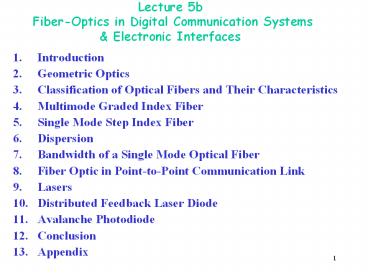Lecture 5b PowerPoint PPT Presentation
Title: Lecture 5b
1
Lecture 5b Fiber-Optics in Digital Communication
Systems Electronic Interfaces
- 1. Introduction
- Geometric Optics
- Classification of Optical Fibers and Their
Characteristics - Multimode Graded Index Fiber
- Single Mode Step Index Fiber
- Dispersion
- Bandwidth of a Single Mode Optical Fiber
- Fiber Optic in Point-to-Point Communication Link
- Lasers
- Distributed Feedback Laser Diode
- Avalanche Photodiode
- Conclusion
- Appendix
2
(No Transcript)
3
Geometric Optics (Physical Background)
- Dual Nature
- A. Huygens's Principle and Ray Approximation
- Huygens's principle states that all points on a
wavefront can be taken as point sources for the
production of secondary wavelets. - We can assume that the wave travels
through a medium in a straight line. This is the
ray approximation, and it assumes that light
behaves like particles traveling in a straight
line. - Diffraction
- When light passes through an aperture, the ray
approximation is valid if the light wavelength is
much shorter than the dimensions of the aperture.
4
(No Transcript)
5
C. ReflectionWhen light encounters a surface,
some light will be absorbed by the surface, some
light will be transmitted through the surface,
and some light will be reflected by the surface.
6
D. Formats Principle Formats principle
states that when a light ray travels between two
points via surface, its path will be the one
that requires the least time. This effect is
called refraction.
7
Single-mode Step Index Fiber
- long-haul telecommunications 100 Gbps for 1 km
repeater spacing of up to 300 km, but these
capabilities continue to be improved. - Axial transmission. For a given core diameter,
there is a minimum wavelength ?c . A single mode
fiber will transmit only the single mode for all
wavelengths greater than the cut-off wavelength
?c .
Cutoff wavelength ?c for a fiber with a
3-micrometer core diameter, a core index of
refraction of 1.545, and a cladding index of
refraction of 1.510.
8
Bandwidth of a Single Mode Optical Fiber
- Single mode fiber has a core diameter 4-9
micrometers, about four times the wavelength of
light, allows only one mode (single mode) to
exist in the core. No bouncing, destructive or
constructive interference occurs. - Typical bit rate is 100 Gb/s/km. This is 5000
times the bit rate of multi-mode fiber.
Theoretical BW limit is 100,000 GHz. - Single mode is the highest bandwidth optical
fiber and is used for long distance
communications. - The single mode fiber bandwidth limitations is
due to different light wavelength traveling at
slightly different speeds. This phenomena is
called chromatic dispersion. - Using single mode 100 km optical fiber between
repeaters bit rate
9
Lasers Light Amplification by Stimulated
Emission of Radiation The laser uses
several heavily doped layers of p-type and n-type
materials. When a large forward bias is applied,
a large number of free holes and electrons are
created in the immediate vicinity of the
junction. When a hole and electron pair collide
and recombine, they produce a photon of light.
-
10
11
Avalanche photodiode
12
Point-to-Point Communication Link
13
Basics of semiconductor theory
14
(No Transcript)
15
(No Transcript)
16
(No Transcript)
17
Laser Beam External Modulation
2
L
1
2k ?/2, Max
?1500 nm L2cm
K0,1,2.
?1500 nm L2cm
(2k1) ?/2, Min
18
Transphasor.
indium antimonide
1000 times faster
19
By DWDM splitting of a spectrum into hundreds of
channels, Decreasing of duration of pulses,
Speed of transfer of the information on a
separate line (one single wavelength) now managed
to be up to 10 Gb per second, and 40-3200 Gb on
main channel.
20
Orbital angular moment of photons
A B C D E F
G H I
1011001001
A
A

